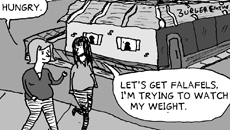
Test Head by Julian Hoeber
Alumnus, Writer and Independent Curator
It’s a trajectory many SAIC students aspire to follow. In four years, SAIC alumnus Marc LeBlanc transitioned from student director and owner of 1R Gallery to independent curator. In 2003, LeBlanc graduated from SAIC with a BFA in sculpture and digital photography. He was featured in FNewsmagazine in 2002, 2003 and 2004 for his art and direction at 1R Gallery. Since then, he’s built up quite the resume: curatorial work for six venues, about 40 reviews, features, interviews, and catalog essays, two residencies, and an MA in Exhibition and Museum Studies. His current show, Constellation, is at Kavi Gupta gallery until Oct. 11.
Dana Boutin: You directed 1R Gallery, which had openings on the second Fridays of the month to avoid competing with West Loop galleries. Six years later, how does it feel to curate an exhibition in the West Loop, one that debuted on the Chicago gallery scene’s biggest night of the year?
Marc LeBlanc: Van [Harrison] and I ran the 1R gallery in Pilsen for the first year and in the West Loop for three more years. I don’t make a large distinction between running a gallery in the West Loop versus elsewhere in the city.
I knew there would be a larger crowd in September and I wanted a lot of the community to see it, especially the young artists. Kavi’s space is one of the only Chicago spaces I wanted to curate at, so I was thankful for that.
DB: In 2002, FNews described 1R as market-savvy, enduring, and devoid of the furnishings that linger in many apartment galleries. How did this initial curatorial experience shape your ideas about presentation and space?
ML: In hindsight, I wasn’t interested in running an apartment gallery. People move everything out to make their living room look like a commercial space. That’s not an apartment gallery. And that’s what I did. From the get-go, we tried to engage a market. Contrary to a lot of popular sentiment, I’ve never been one much for democracy in exhibiting art. I’ve primarily been interested in selling work. A lot of decisions we made were not about salability of work, but we were always aware of the fact that if we didn’t want the artists to have to continue their crappy day jobs, they needed to sell work. That’s not a popular answer. But it’s the truth of the matter, and I have no qualms about making money off of art.
When organizing an exhibition, I never want to be in a situation where I’m ashamed of or unhappy with the outcome. That means being refined and deliberate about what you do and not accepting any compromises on what you want something to look like. The show is up for six weeks. Its pictures are around for who knows how long. I’ve done exhibitions in the past where I’ve been dissatisfied. The best method for preventing that in the future is being unrelenting about what you won’t accept.
How I’ve used space has changed a lot. I’m very conscious now of not having exhibitions that are overhung and of what I call the physical drama of the space—the way the pieces are related in the space. In Constellation I went against having any proportional hanging of the work. Everything in that exhibition is incredibly important to me and translating that to a viewer is my utmost concern.
DB: In 2004, you advised students aspiring to create their own galleries, saying, “Research, plan, make sure you realize all the implications of running a business, the demands and setbacks.” What advice would you now give students who want to become curators?
ML: I don’t run a gallery now, and trying to run a gallery when I was between the ages of 19 and 24 was pure folly. Real commercial spaces have excellent capitalization behind them. They are run by people who are in their forties, know established artists, know emerging artists, and know people who can buy work.
Running an apartment gallery is a wonderful experience and you can get a lot out of it. But when I read [what I said in 2004], I would say exactly the opposite. You don’t need to know the implications of running a business. If you’re running an apartment gallery, it should be exactly not that. If you turn an apartment gallery into a commercial gallery without a budget, you’re only going to have a house of cards.
DB: How is the inter-contextualizing of disparate media in Constellation important to its meaning to what you call the “metaphysical purpose of art making”?
ML: Discussions about the history of disciplines were always present when I went to art school. I have always been dissatisfied when talking about media as they exist inside their disciplines. I craft my language about art so that it cuts across discipline discussions. That means talking about genre and style. Whether somebody is creating comedies or tragedies. Subjects that don’t pertain to any specific medium.
DB: In 2003, you were “partial to work with a sense of humor, work that is playful … and life affirming.” But the bullet holes in Julian Hoeber’s “Test Head” evoke violence and death, themes common to Hoeber’s work. How would you describe your aesthetic taste now?
ML: It’s the same. I think Julian’s work is life affirming. We live in a world of loss and death. I’m still partial to work with a sense of humor, that’s playful and life affirming. I don’t like work that’s self-interested or that says, “I’m speaking on behalf of me and my group.” I look for work by people who believe that art should transcendent that.
DB: Your thesis centers on “participatory art events as they relate to online fan communities and other pervasive media.” I’d like to know more about how you think online communities affect the art world.
ML: I see probably 92 percent of the work I look at through the Internet. I will spend a day and look at galleries in Brussels, Geneva, Seoul, Tokyo, L.A., and Atlanta. I’m able to look at all their paintings, sculptures and space online. I read art magazines, blogs and online journals to follow the market and what’s happening regionally and internationally. When looking for work, I find people’s blogs, map out links, track down artists’ websites and contact them. I don’t show work by anybody I haven’t met. It’s common now for collectors to buy work from a JPEG. That’s how the bulk of dealers I know do a lot of business now.
A lot of contemporary discourse centers on participation with a specific art event. For me, participation is when I get up in the morning and flip through gallery websites. Those hits. When I go to get a torta and go to the shows—from the second that I leave my house with the intention of having that event, I’m participating in art.
DB: Is there a certain area in the world in which you have particular interest? You went to Japan, right?
I liked how people addressed art making in Tokyo. I would ask somebody, “do you make art?” and they would say, “no, but I can show you all these paintings I’ve made” or “no, I just fill these notebooks with drawings.” There’s an interesting discord that happens that’s really nice. You realize that somebody’s ontology—the fundamental way that they perceive what art is—is completely different from yours.
DB: What are your thoughts on the role of reviews in the art world?
ML: Writing reviews is invaluable. Things that are visual want to be put into text. What happens in music happens between music and drama. What happens in visual art often happens between art and writing. It’s always been that way and it’s not going to change. A title is the first transposition of a work from a visual into text. The aesthetic of a work makes its way through the world by being transposed into other things.
More Info:
Kavi Gupta Gallery is located on 835 W. Washington, off of Peoria St. For more on Marc LeBlanc, visit his website or read the other FNews articles from when Marc was a SAIC student.







